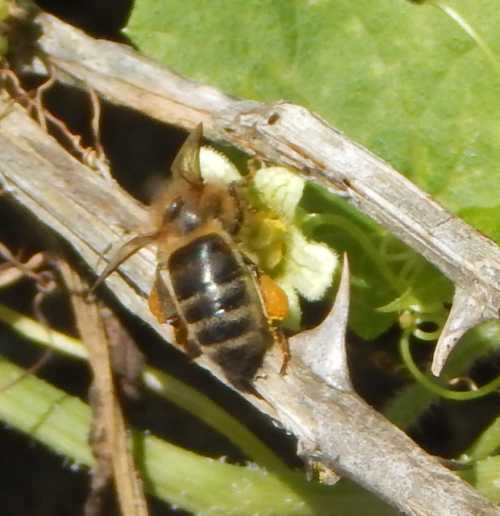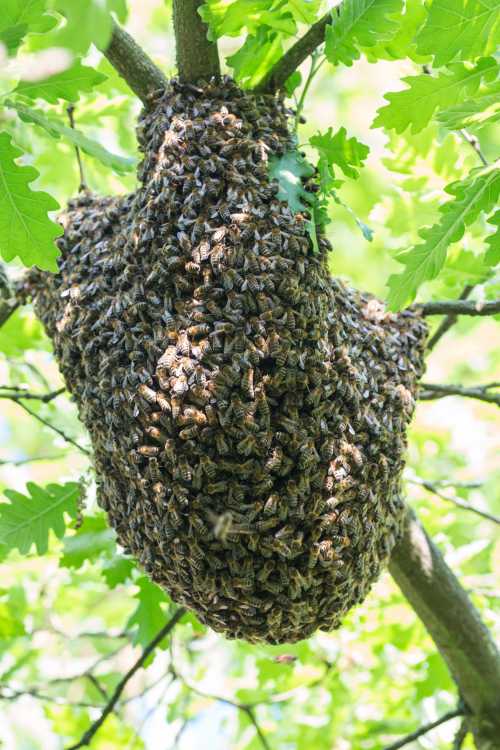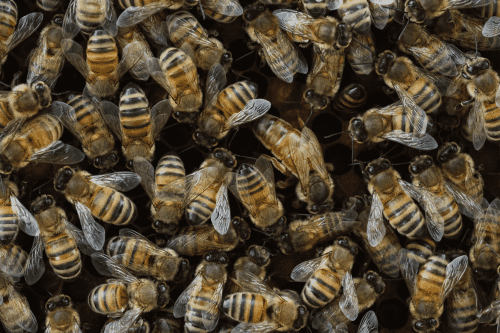How Do Bees Communicate?
A colony of honey bees is a superorganism that communicates in various ways, via physical, chemical, and acoustic mechanisms.
How Bees Communicate
Here, the known methods of communication in honey bees are broadly outlined, from the use of pheromones to dancing, piping and feeding.
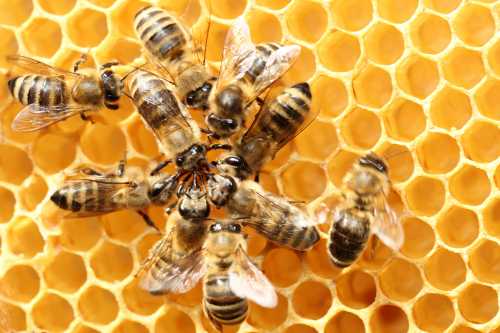
Pheromones
Honey bees use a number of chemical signals called ‘pheromones’ to communicate and initiate behaviours among colony members.
Not only have scientists found that all caste members within a colony (queen, workers, drones) use pheromones to communicate, the brood (eggs, larvae and pupae still in their cells) also emit pheromones that affect behaviour, particularly in the workers.
Glands producing pheromone chemicals used for communication include, for example, the mandibular glands in the mandibles, Nasanov glands in the abdomen, Dufour's and Koschevnikov glands in the sting, and Amhart (footprint) glands.
(Read more about How Bees Use Pheromones).
However, perhaps the most famous among the pheromones used by
bees, are:
- The alarm pheromones
Alarm pheromones are especially used by guard worker bees as a means to stimulate defensive action against threats, for example, by attracting other bees to help defend against a predator (such as a wasp or hornet) at a hive entrance.
Bees disperse the alarm pheromones by raising their abdomens, thrusting their stingers outward and fanning their wings1.
- The queen signal
The queen uses a combination of pheromones which create the ‘queen signal’.
The queen signal, along with other pheromones, helps to ensure the smooth running of the colony and maintains the hierarchy in which worker bees efficiently perform their functions within this amazing superorganism.
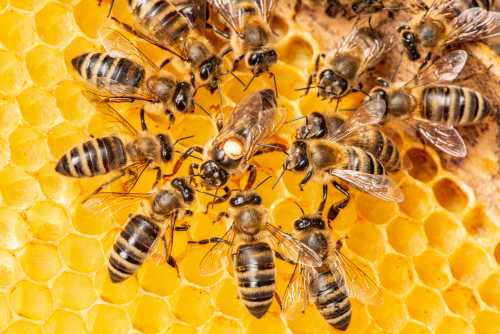 Here, a queen is surrounded by her worker 'retinue'. It is suggested that the queen's signal encourages such behaviour among her workers. The dominance of the queen is reinforced, and the workers will groom and feed her.
Here, a queen is surrounded by her worker 'retinue'. It is suggested that the queen's signal encourages such behaviour among her workers. The dominance of the queen is reinforced, and the workers will groom and feed her.- The Nasonov gland pheromone
This pheromone is used by worker bees during swarming, recruiting foragers and selecting new queens.
Trophallaxis
Trophallaxis is the transfer of food and fluids from the mouth of one bee to the mouth of another.
The drones and the queen consume food passed on to them by workers, but they do not donate it themselves.
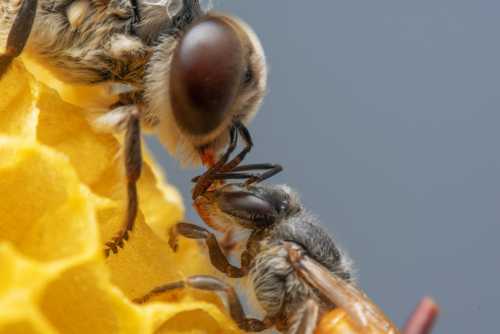
Workers
are both recipients and donors, passing food between fellow workers, and also to the
queen and drones2.
When honey bee workers engage in trophallaxis, they share the content of their crops and sometimes the products of their head glands2.
Scientists suggest that the transfer of food between bees provides information to colony members about the quality and quantity of food existing in the hive2, as well as communicating about pollen needs for the colony3.
The Honey Bee ‘Waggle’ Dance
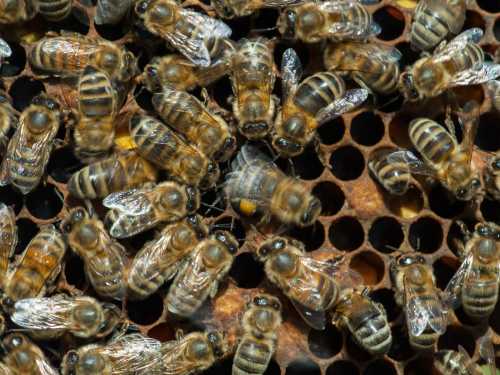
Honey bees are famous for their waggle dance.
First understood as the method by which returning foragers would communicate the location of food sources to colony members, it is now understood that:
- the dance is also used by water gathering bees to provide directions to a water source, and
- scout bees perform a dance to communicate the location of a potential new nest site.
Acoustical signals (piping, tooting, ‘quacking’, hissing)
Bees may also use sounds to communicate.
A number of noises, notably piping, tooting quacking and sometimes hissing sounds may be used.
Queens make a variety of sounds that serve to prevent conflict, and are predictive of swarming behaviour4.
In addition, tooting and quacking occurs between rival queens. (A new queens may ‘toot’ when she emerges from a cell, rival queens ‘quack’), and it is suggested that queens pipe loudly in the nest or hive to signal to their workers that they have a productive, healthy and active queen4.
Scientists suggest that honey bee workers also use acoustic signals. Workers make excited pulsing sounds (piping):
- During colony disturbance
Disturbance or threat to the colony can initiate worker piping, and also result in hissing5.
Hissing has been observed to act as a warning signal to potential predators, such as hornets. - Prior to swarming
Scientists suggest that worker piping prior to swarming, stimulates bees to warm up and prepare for lift off6. - As a ‘stop signal’
Workers called ‘tremble dancers’ emit a short pipe or ‘beep’ when they encounter a nestmate performing a waggle dance for foraging recruitment to a source of nectar. Its effect is to put a stop to the dancing, resulting in recruitment to nectar sources6.
Bee Antennae - Information Receivers
Communication is a two-way process: giving out messages, and receiving them.
In bees, the antennae are of vital importance in detecting communication from other bees, since the antennae collect information via sensitivity to vibration from sound, as well as detecting chemical signals (pheromones), taste and scent.
References
1. López-Incera, A., Nouvian, M., Ried, K. et al. Honeybee communication during collective defence is shaped by predation. BMC Biol19, 106 (2021). https://doi.org/10.1186/s12915-021-01028-x
2. Karl Crailsheim. Trophallactic interactions in the adult honeybee (Apis mellifera L.). Apidologie, Springer Verlag, 1998, 29 (1-2), pp.97-112. ffhal-00891482f
3. Liao, LH., Wu, WY. & Berenbaum, M.R. Behavioral responses of honey bees (Apis mellifera) to natural and synthetic xenobiotics in food. Sci Rep7, 15924 (2017). https://doi.org/10.1038/s41598-017-15066-5
4. Ramsey, MT., Bencsik, M., Newton, M.I. et al. The prediction of swarming in honeybee colonies using vibrational spectra. Sci Rep 10, 9798 (2020). https://doi.org/10.1038/s41598-020-66115-5
5. Sen Sarma M, Fuchs S, Werber C, Tautz J. Worker piping triggers hissing for coordinated colony defence in the dwarf honeybee Apis florea. Zoology (Jena). 2002;105(3):215-23. doi: 10.1078/0944-2006-00064. PMID: 16351870.
6. Seeley, Thomas & Tautz, Juergen. (2001). Worker piping
in honey bee swarms and its role in preparing for liftoff. Journal of
Comparative Physiology. 187. 667-676. 10.1007/s00359-001-0243-0.
If you found this page helpful or interesting, I'd really be grateful if you would share it with others - if not this page, perhaps another, such as Gardening For Bees.
Thank you so much :) .
